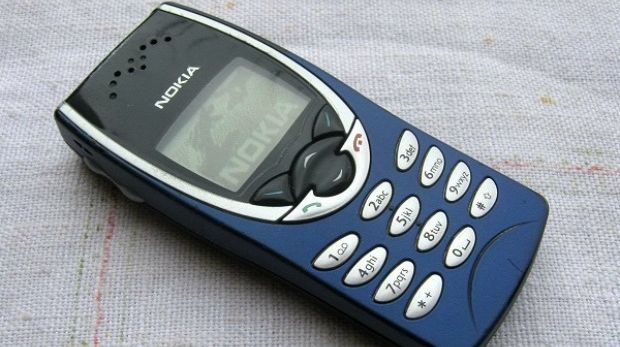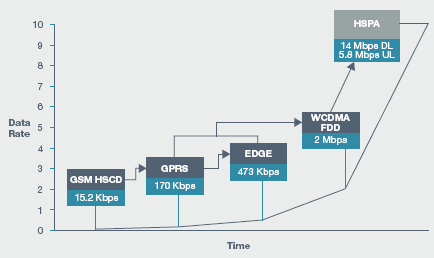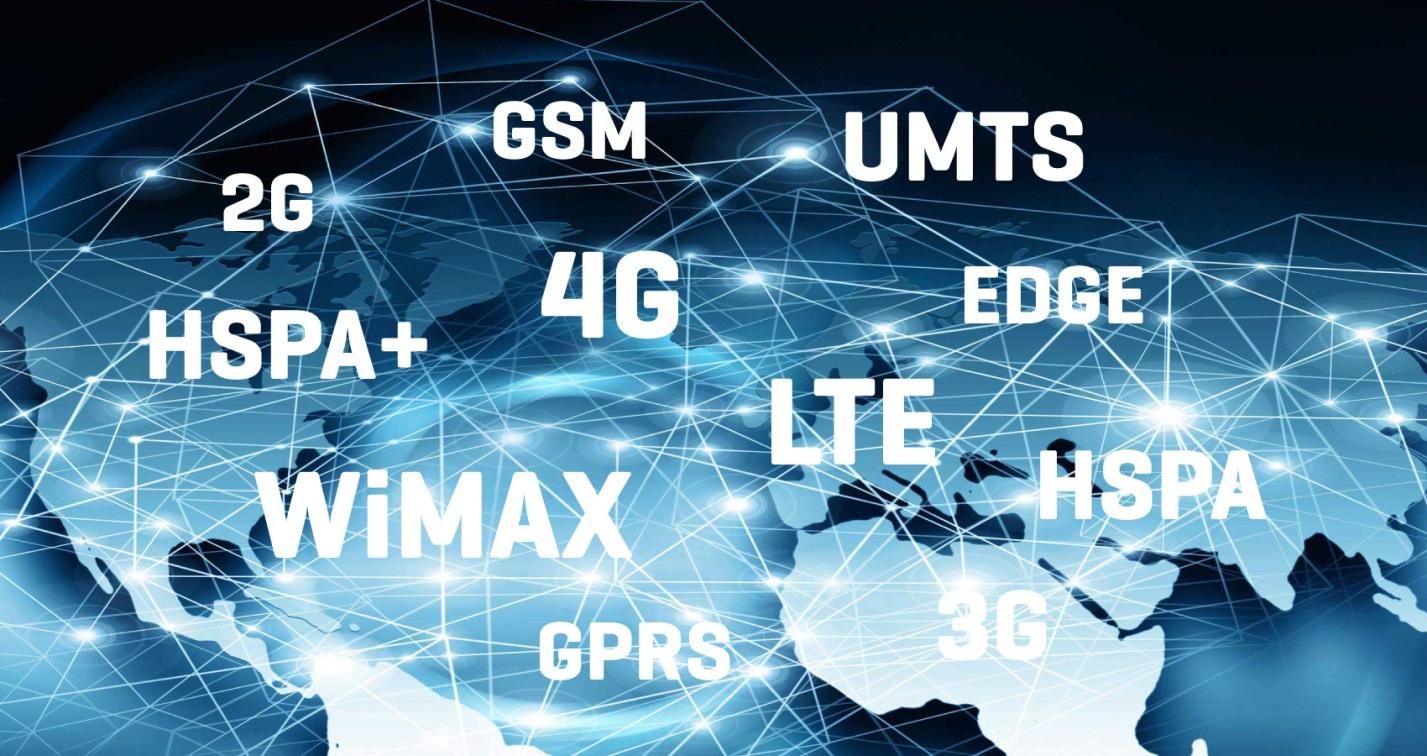The history of the mobile Internet: 1991 - our days

A source
Although the smooth evolution of mobile Internet took decades (and continues to this day), mobile access to data began to rapidly change our lives in the early and mid-2000s, when third-generation networks were spreading.
As the phones became smaller and more productive, the Internet adapted to mobile platforms, the data transfer rate grew (4G networks improved their bandwidth by about ten times compared to 3G), mobile communications became ubiquitous.
Today we will tell the story of the legendary technological breakthrough in telecom: the transition of technology from laboratory stands to mass distribution throughout the world.
2G: the beginning of the mobile Internet networks

')
The European Telecommunications Standardization Institute , established in 1988, designed GSM (Groupe Special Mobile) as a solution that will open up new voice telephony features. In fact, it was a system for phone calls - no one thought that GSM might be needed for mass Internet use.
The fact that the transfer of data on new devices has become digital, rather than analog, has allowed us to develop many of the basic functions of the smartphone, which are now used as the basis of the mobile Internet. Features such as text messaging, content download and extremely easy access to the network, gave consumers the ability to send emails, browse websites and download simple media content (ring tones and music files).
Already on December 3, 1992, the 22-year-old employee of the Sema Group Neil Papworth tested a new technology for the cellular operator Vodafone by sending a short text message - SMS. It contained just two words: “Merry Christmas.” At that moment, the network still did not allow sending SMS from the telephone to the telephone, therefore the first message was transmitted from the computer. Initially, SMS technology was only available on GSM networks, but eventually spread to all digital networks.
In 1997, the three leaders of the mobile market of that time - Ericsson, Motorola and Nokia - united to “make friends” with the Internet and mobile communications using the WAP ( Wireless Application Protocol ). WAP described a method by which a mobile device could access Internet resources without using other devices (for example, a modem).
Over the course of several months, most of the major cellular infrastructure manufacturers have become project participants. Already in May 1998, the first edition of WAP, v.1.0, was published. In this protocol, data transfer rates ranged from 9.6-56 Kbps.
In October 1999, together with the debut of the Nokia 7110, the Dutch mobile operator Telfort BV launched the first WAP site ( example ), which was adapted for viewing on mobile phones. In terms of speed, ease of use and appearance, the WAP site lags far behind users' expectations.
In addition, the first WAP-phones were not adapted to the Internet. Remember how you had to use the network before the ubiquitous touch screens. Connection to WAP-services was not included in the monthly tariff plans and was charged separately. In addition, the connection speed was very low.
WAP protocol survived until 2013, after which its use ceased. Most Internet browsers began to support HTML, CSS and JavaScript. No longer needed to use WAP markup to ensure backward compatibility of web pages. HTML began to support all Android devices, all Blackberry devices, all versions of the iPhone, all devices running Windows Phone and many Nokia phones. Smartphones finally turned into a mini-PC with a constant connection to the Internet.
However, WAP has lost all prospects from the beginning of the 2000s. At that time, the rapid development of GPRS and EDGE began. In 2000, both the first commercial services and the first phones with support for the General Packet Radio Service ( GPRS ) appeared. In 2001, GPRS, standardized by the European Telecommunications Standards Institute, was launched worldwide as a service provided within GSM for providing access to the mobile Internet. In 2G systems GPRS provides data rates in the range of 56-114 Kbps.
2.5G: EDGE
Later, the Enhanced Data Rate for GSM Evolution ( EDGE ) add-on appeared on the GPRS base for faster data transfer, so the access protocol has not changed. The data is collected in packets and transmitted through a virtual channel, which is provided to the subscriber during the GPRS session. Concepts that provide packet data in cellular radio networks have been preserved and developed further from GPRS / EDGE to 3G and 4G.
GSM EDGE was first introduced in 2003 in North America. By implementing sophisticated data encoding and transmission methods, EDGE provides higher bit rates per radio channel. EDGE can have data bandwidth up to 236 Kbps (with a full delay of less than 150 ms) with a theoretical maximum of 473.6 Kbps.

Load time of real files depending on the technology.
At the end of the 2000s, attempts were made to improve 2.5G throughput using the Evolved EDGE standard, also known as EDGE Evolution. In this standard, delays are reduced, and the speed is increased to 1 Mbit / s.
Many telecom operators sought to upgrade the existing infrastructure, rather than invest in a new one. Thanks to software updates and new devices that are compatible with Evolved EDGE, many service providers wanted to avoid investing in 3G. However, this standard was never put into commercial use.
3G: first high-speed access
As 2G spread and people of all ages began using phones in their daily lives, there was an obvious increase in demand for data. Users increasingly demanded an increase in data transfer speeds. Since 2G could not cope with this task, a new technology was created.
3G introduced in Japan in May 2001. The main technological difference between 3G and 2G was the use of packet switching (3G), rather than circuit switching (2G). At the same time, 3G speed has increased on average up to 2 Mbit / s. (from 200 Kbps at the beginning of technology implementation). There was a revolution that can be compared only with the transition from 56k-modems to broadband access.
Thanks to reliable, fast connection, streaming video services on the phone, including video calls, began to develop rapidly. Most sites have got versions for mobile devices. In general, since the mid-2000s, 3G has significantly changed the web industry, especially in terms of applications and web interactivity.

HSDPA compared to WCDMA , EDGE, GPRS, GSM.
With the advent and spread of 3G, the modern era of wireless mobile smartphones as handheld computers began, especially after 2005, when High-Speed Downlink Packet Access (HSDPA) was introduced in 3G. In HSDPA (also called 3.5G, 3G +, Turbo 3G) the maximum theoretical data transfer rate according to the standard was 14.4 Mbit / s. (from the base station to all local subscribers) and up to 5.76 Mbit / s. from the subscriber.
However, by 2009 it became clear that at some point 3G networks would be overloaded with traffic from applications that need access to the network. Soon, the industry focused on the introduction of 4G technology, intending to increase the speed several times in comparison with existing 3G networks.
4G

A source
The first 4G technologies were introduced in the USA (WiMAX is based on the IEEE 802.16 standard, the bandwidth of one base station with six sectors and a bandwidth of 20 MHz is 180 Mbps) and Scandinavia (LTE has a bandwidth of 326.4 Mbps towards the subscriber and 172.8 Mbit / s towards the base station).
In a short counter, WiMAX (Worldwide Interoperability for Microwave Access) lost LTE (Long-Term Evolution). Both standards are conditionally related to the fourth generation of communications (4G), first launched in Russia by the Yota operator, while the main advantage of LTE is continuity with respect to 3G (UMTS / HSPA, HSPA +). WiMAX is a separate branch of evolution, which was constrained by a limited number of subscriber devices, the actual absence of roaming and the failure of major vendors and mobile operators to invest.
4G technology has almost equalized the speed of mobile Internet and home broadband connection. The existing general standard defines 4G as a network in which 100 Mb / s. available for subscribers in motion and up to 1 Gbit / s. in ideal conditions (subscriber unit does not move). In this case, the delay varies from 20 to 50 ms.
5G

A source
The standard is not yet implemented, but is being actively tested at speeds of 1-20 Gbit / s. The transition to it is expected in the next few years. 5G will provide not only high speed data transmission, but also give impetus to the development of such technological areas as unmanned vehicles and smart cities as part of the development of the Internet of Things ( supporting simultaneous connection of up to 100 million devices per square kilometer with a delay of no more than 1 millisecond).
In Russia, the first 5G network is already operating on the territory of the Skolkovo innovation center. In addition, it is expected that 5G will work on some stadiums that will host the FIFA World Cup this summer.
Source: https://habr.com/ru/post/352450/
All Articles